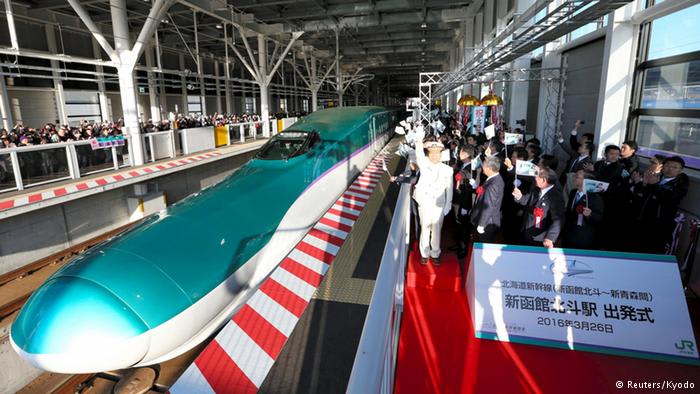2016年5月26日(Thu.) ドイツを鉄道で旅したことがある人にはなじみ深いものがあるかも知れません。ICE( Intercity Express )に関する短いニュースです。(ニュースソース: DW-DE 5月25日発 )
<原文の一部>
Happy Birthday, Intercity Express!
The ICE is turning 25. On May 25, 1991, five high-speed trains zoomed from different corners of the German republic to converge on the city of Kassel, ushering in the era of the white trains dubbed the Intercity Express.

King of the rails
Every German knows the ICE. That's according to ICE operator Deutsche Bahn, which claims the ICE brand has a 100 percent recognition rate. The high-speed train is Deutsche Bahn's flagship, although it accounts for only 8 to 10 percent of the railway's total revenues.

New model unveiled
A new ICE 4, at its unveiling in Berlin in December 2015, as an ICE 3 races past. The new model is expected to run within test operations starting in autumn this year, and have its place on the normal train timetable in 2017. The ICE 4 is close to 350 meters (382 yards) long and seats 830 passengers.

International competitors
The fastest of all trains based on conventional rail technology is France's TGV (Train à Grande Vitesse). It's been around since 1981. The newest version, the AGV, reached a speed of 574 km/h (356 mph) in 2007, compared to its normal operating speed of 320 km/h. TGV trains can be found in Germany, Belgium, the UK, Switzerland, and Italy.

Japan, the high-speed pioneer
Even before the French, Japanese engineers developed a high speed train - the Shinkansen. An early model of this train ran at speeds of 210 km/h during the 1964 Summer Olympics in Tokyo. The newest model, like the one pictured here, runs at a maximum speed of 320 km/h.

Racing into the future at supersonic speed
The Hyperloop is a conceptual high-speed transport system originally put forward by Tesla founder Elon Musk.It incorporates reduced-pressure tubes in which pressurized capsules ride on an air cushion driven by linear induction motors and air compressors, allowing for speeds of more than 1,200 km/h.

(抜粋)1991年の5月25日から、25年目を迎えたICEです。 写真を中心に、鉄道の歴史、フランスのTGVや日本の新幹線などのコンペチター、そして、未来の超音速列車(1200km/h以上)などを簡単に紹介しています。
ちなみに、ICEはドイツ人なら誰でも知っていますが、DB( Deutsche Bahn: ドイツ鉄道 )の売上の8~10%を占めるに過ぎない・・・とコメントしています。
また、次期ICE(4)は、2015年12月に公表されましたが、今年(2016)の秋には試験走行、そして、2017年には営業運転に入る予定で、乗客定員は830人と伝えています。
***
2013年にドイツ滞在した時、DB及びICE等には幾度もお世話になったものです。その他のローカル線列車も含めて、正確な運行がされていたと記憶しています。また、列車(車内も)は綺麗で、女性の運転士を見かけたことも思い出します。
また、DBのHP(ホームページ)では、鉄道時刻なども容易に検索でき、移動計画を立てる時などには、結構重宝しました。ちなみに、英文での表示もありますので、問題なく利用できます。但し、行先などの地名には、ドイツ語特有の文字入力も必要になります。
*
こうした鉄道網や、シェンゲン協定国間の自由移動などが、EU各地での交流などを容易にしている大きな要因の一つなのでしょう。もっとも、そうした事情が、テロリストや難民等の流入を容易にしてしまっている・・・とも言えるのでしょうね。
何れにせよ、何事にも言えることかも知れませんが、様々な問題・課題の解決には、相応の時間が必要なのでしょう。逆に、性急な解決や変革を求めることは、反発を招くこともあるのかも知れません。
いつか早い時期に、EUを鉄道でも旅したいし・・・、そうした安全で平和なEU(世界)等の構築を望みたいものです。しかし、伊勢志摩サミットの成果に、それを期待するのは性急かも知れませんね。
*** 下の写真は、記事内容とは関係ありません。 ( Arielle Kebbel )




***
<原文の一部>
Happy Birthday, Intercity Express!
The ICE is turning 25. On May 25, 1991, five high-speed trains zoomed from different corners of the German republic to converge on the city of Kassel, ushering in the era of the white trains dubbed the Intercity Express.

King of the rails
Every German knows the ICE. That's according to ICE operator Deutsche Bahn, which claims the ICE brand has a 100 percent recognition rate. The high-speed train is Deutsche Bahn's flagship, although it accounts for only 8 to 10 percent of the railway's total revenues.

New model unveiled
A new ICE 4, at its unveiling in Berlin in December 2015, as an ICE 3 races past. The new model is expected to run within test operations starting in autumn this year, and have its place on the normal train timetable in 2017. The ICE 4 is close to 350 meters (382 yards) long and seats 830 passengers.

International competitors
The fastest of all trains based on conventional rail technology is France's TGV (Train à Grande Vitesse). It's been around since 1981. The newest version, the AGV, reached a speed of 574 km/h (356 mph) in 2007, compared to its normal operating speed of 320 km/h. TGV trains can be found in Germany, Belgium, the UK, Switzerland, and Italy.

Japan, the high-speed pioneer
Even before the French, Japanese engineers developed a high speed train - the Shinkansen. An early model of this train ran at speeds of 210 km/h during the 1964 Summer Olympics in Tokyo. The newest model, like the one pictured here, runs at a maximum speed of 320 km/h.

Racing into the future at supersonic speed
The Hyperloop is a conceptual high-speed transport system originally put forward by Tesla founder Elon Musk.It incorporates reduced-pressure tubes in which pressurized capsules ride on an air cushion driven by linear induction motors and air compressors, allowing for speeds of more than 1,200 km/h.

(抜粋)1991年の5月25日から、25年目を迎えたICEです。 写真を中心に、鉄道の歴史、フランスのTGVや日本の新幹線などのコンペチター、そして、未来の超音速列車(1200km/h以上)などを簡単に紹介しています。
ちなみに、ICEはドイツ人なら誰でも知っていますが、DB( Deutsche Bahn: ドイツ鉄道 )の売上の8~10%を占めるに過ぎない・・・とコメントしています。
また、次期ICE(4)は、2015年12月に公表されましたが、今年(2016)の秋には試験走行、そして、2017年には営業運転に入る予定で、乗客定員は830人と伝えています。
***
2013年にドイツ滞在した時、DB及びICE等には幾度もお世話になったものです。その他のローカル線列車も含めて、正確な運行がされていたと記憶しています。また、列車(車内も)は綺麗で、女性の運転士を見かけたことも思い出します。
また、DBのHP(ホームページ)では、鉄道時刻なども容易に検索でき、移動計画を立てる時などには、結構重宝しました。ちなみに、英文での表示もありますので、問題なく利用できます。但し、行先などの地名には、ドイツ語特有の文字入力も必要になります。
*
こうした鉄道網や、シェンゲン協定国間の自由移動などが、EU各地での交流などを容易にしている大きな要因の一つなのでしょう。もっとも、そうした事情が、テロリストや難民等の流入を容易にしてしまっている・・・とも言えるのでしょうね。
何れにせよ、何事にも言えることかも知れませんが、様々な問題・課題の解決には、相応の時間が必要なのでしょう。逆に、性急な解決や変革を求めることは、反発を招くこともあるのかも知れません。
いつか早い時期に、EUを鉄道でも旅したいし・・・、そうした安全で平和なEU(世界)等の構築を望みたいものです。しかし、伊勢志摩サミットの成果に、それを期待するのは性急かも知れませんね。
*** 下の写真は、記事内容とは関係ありません。 ( Arielle Kebbel )




***









